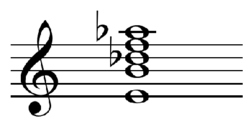
| Component intervals from root | |
|---|---|
| diminished fourth | |
| minor second | |
| diminished seventh | |
| perfect fifth | |
| root | |
| Forte no. / | |
| 5-32 / |
The Elektra chord is a "complexly dissonant signature-chord"[1] and motivic elaboration used by composer Richard Strauss to represent the title character of his opera Elektra that is a "bitonal synthesis of E major and C-sharp major" and may be regarded as a polychord related to conventional chords with added thirds,[2] in this case an eleventh chord. It is enharmonically equivalent to a 7#9 chord : D♭-F-A♭-C♭-E and a 6b9 chord : E-G#-B-C#-F.

In Elektra the chord, Elektra's "harmonic signature" is treated various ways betraying "both tonal and bitonal leanings...a dominant 4/2 over a nonharmonic bass." It is associated as well with its seven note complement which may be arranged as a dominant thirteenth[1] while other characters are represented by other motives or chords, such as Klytämnestra's contrasting harmony. The Elektra chord's complement appears at important points and the two chords form a 10-note pitch collection, lacking D and A, which forms one of Elektra's "distinctive 'voices'"[3]

Use in other works[edit]
The chord is also found in Claude Debussy's Feuilles mortes, where it may be analyzed as an appoggiatura to a minor ninth chord, and Franz Schreker's Der ferne Klang, and Alexander Scriabin's Sixth Piano Sonata.[2]
See also[edit]
References[edit]
- ^ a b Lawrence Kramer. "Fin-de-siècle Fantasies: Elektra, Degeneration and Sexual Science", Cambridge Opera Journal, Vol. 5, No. 2. (Jul., 1993), pp. 141-165.
- ^ a b H. H. Stuckenschmidt; Piero Weiss. "Debussy or Berg? The Mystery of a Chord Progression", The Musical Quarterly, Vol. 51, No. 3. (Jul., 1965), pp. 453-459.
- ^ Carolyn Abbate, 'Music and Language in Elektra', in Richard Strauss: Elektra, ed. Derrick Puffett, Cambridge Opera Guides (Cambridge, 1989), 107-27. Cited in Kramer (1993), p.156.


Well, that’s interesting to know that Psilotum nudum are known as whisk ferns. Psilotum nudum is the commoner species of the two. While the P. flaccidum is a rare species and is found in the tropical islands. Both the species are usually epiphytic in habit and grow upon tree ferns. These species may also be terrestrial and grow in humus or in the crevices of the rocks.
View the detailed Guide of Psilotum nudum: Detailed Study Of Psilotum Nudum (Whisk Fern), Classification, Anatomy, Reproduction